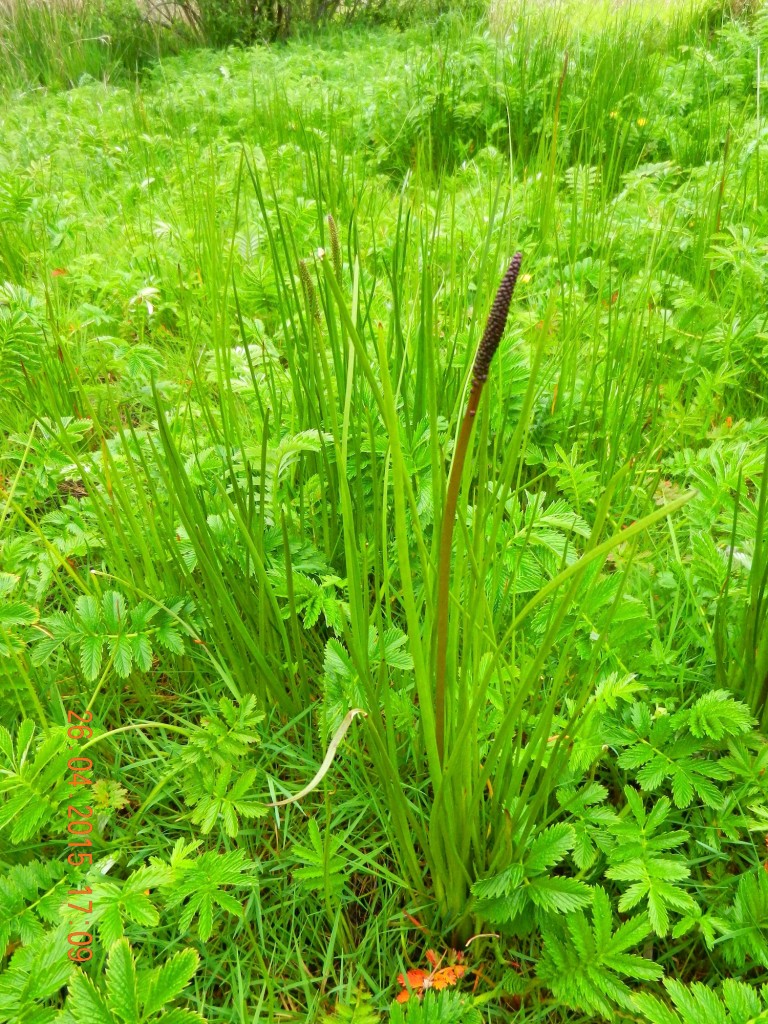 Triglochin maritima grows in the marsh of Gooch Creek
Triglochin maritima grows in the marsh of Gooch Creek
Each year I harvest last years stems of Phragmites in my estuary/marsh for mason bee tubes. It is important that this is done in the early spring only before new shoots start to emerge. I have a theory that this native Phragmites exists in this particular marsh only because the marsh was fenced in the early years to prevent grazing by cattle and sheep. It has been eliminated from most of the other marshes in BC by grazing (personal communication with Robert Prescott-Allen). The reason this marsh was fenced probably was that the plant Triglochin maritima (Sea arrow grass) grows in the marsh and it is toxic to grazers. ( see below)
Scientific classification
Kingdom: Plantae
(unranked): Angiosperms
(unranked): Monocots
Order: Alismatales
Family: Juncaginaceae
Genus: Triglochin
Species: T. maritima
Binomial name
Triglochin maritima L.
The following is a quote from the Canadian Biodiversity Information facility:
General poisoning notes:
Seaside arrow-grass (Triglochin maritima) is a native plant found sporadically across Canada in saline, brackish, or fresh marshes and shores. This plant contains cyanogenic glycosides, which can release HCN during mastication by animals. Poisoning occurs primarily with ruminants, including cattle and sheep. The concentration of toxic chemicals increases during times of moisture depletion (Majak et al. 1980, Cooper and Johnson 1984, Poulton 1989).
References:
- Beath, O. A., Draize, J. H., Eppson, H. F. 1933. Arrow grass – chemical and physiological considerations. Univ. Wyo. Agric. Exp. Stn. Bull., 193. 36 pp.
- Cooper, M. R., Johnson, A. W. 1984. Poisonous plants in Britain and their effects on animals and man. Her Majesty’s Stationery Office, London, England. 305 pp.
Nomenclature:
- Scientific Name:
- Triglochin maritima
- Vernacular name(s):
- seaside arrow-grass
- Scientific family name:
- Juncaginaceae
- Vernacular family name:
- arrow-grass
Go to ITIS*ca for more taxonomic information on: Triglochin maritima
Toxic plant chemicals:
- taxiphillin
- triglochinin
References:
- Majak, W., McDiarmid, R. E., Hall, J. W., Van Ryswyk, A. L. 1980. Seasonal variation in the cyanide potential of arrowgrass (Triglochin maritima). Can. J. Plant Sci., 60: 1235-1241.
- Poulton, J. E. 1983. Cyanogenic compounds in plants and their toxic effects. Pages 117-157 in Keeler, R. F., Tu, A. T., eds. Handbook of natural toxins. Vol. 1. Plant and Fungal toxins. Marcel Dekker, Inc., New York, N.Y., USA. 934 pp.
Animals/Human Poisoning:
Cattle
General symptoms of poisoning:
Notes on poisoning:
Cyanide poisoning from seaside arrow-grass is similar to symptoms discussed under sheep.
References:
- Cooper, M. R., Johnson, A. W. 1984. Poisonous plants in Britain and their effects on animals and man. Her Majesty’s Stationery Office, London, England. 305 pp.
Sheep
General symptoms of poisoning:
Notes on poisoning:
Cyanide poisoning of sheep by seaside arrow-grass includes the following symptoms: nervousness, trembling, erratic breathing, convulsions, recumbency, and death. Postmortem findings reveal bright red blood and the smell of bitter almonds in the stomach. Treatment, if started early enough, can be successful. Intravenous injections of an aqueous solution of sodium thiosulfate have proved to be effective (Cooper and Johnson 1984).
References:
- Cooper, M. R., Johnson, A. W. 1984. Poisonous plants in Britain and their effects on animals and man. Her Majesty’s Stationery Office, London, England. 305 pp.

